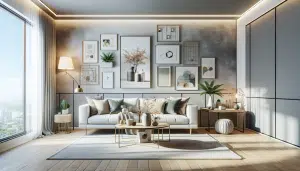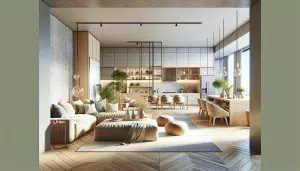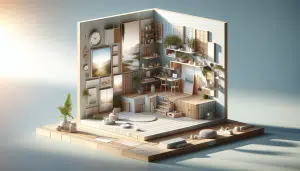Upgrade Your Space With Minimalist Interior Secrets
Lily Carter October 22, 2025
Discover how minimalist interior design can transform any living space into a calming oasis. This guide uncovers essential tips, creative strategies, and real-life inspirations to help you achieve a harmonious and visually stunning home environment. Dive in and explore the essentials for modern minimalist living.
Understanding Minimalism In Interior Design
Minimalism in interior design is about creating serene, clutter-free spaces while retaining personality and style. Many people are drawn to this approach because it focuses on clean lines, open floor space, and functional decor. The philosophy goes beyond simply removing excess; it’s about allowing essential pieces—and those with genuine meaning—to shine. Minimalism’s popularity continues to rise, especially as daily lives become busier and homeowners crave simplicity at home.
Key minimalist elements include neutral colors, natural materials, and deliberate use of empty space. Beginners often find it refreshing since each chosen item gets room to breathe. Rather than overwhelm rooms with lots of decorations, the goal is to showcase a few, high-quality pieces. Upholstered furnishings or soft textiles add comfort, while hidden storage preserves a tidy look. Visitors often remark on the soothing, peaceful vibe that minimalist interiors radiate.
Practicing minimalism doesn’t mean your rooms will feel stark or lifeless. Personal touches—like framed art, indoor plants, or unique lighting—are welcome if thoughtfully placed. Many people experiment with minimalist living rooms by using versatile furniture and subtle décor. It’s about striking the right balance between simplicity and warmth, making your space both welcoming and functional (Source: https://www.archfoundation.org/home-minimalism).
Benefits Of Embracing Minimalist Spaces
A minimalist home offers many psychological perks. Studies increasingly show that clutter may contribute to stress and anxiety. With a pared-down design, daily routines become smoother because items are easy to find and chores are simplified. The reduction in visual noise has been linked to increased productivity and tranquility, making minimalist interiors especially attractive to busy professionals and families alike.
Another benefit involves cleaning and maintenance. Fewer belongings and surfaces make dusting and tidying much easier. The emphasis on multi-functional furniture also supports streamlined living. Homeowners who have adopted these design principles often report feeling more content and less overwhelmed. They’re also likely to invest in higher-quality pieces that last longer, rather than filling rooms with trend-based purchases.
Minimalism is also eco-friendly. Selecting sustainable materials and reducing waste aligns with broader environmental concerns. When only meaningful items are purchased, consumption drops sharply. Indoor air quality can also improve, as there is less accumulation of dust and fewer off-gassing items. People not only enjoy stylish, modern spaces—they support healthier lifestyles for themselves and the planet (Source: https://www.ncbi.nlm.nih.gov/pmc/articles/PMC5557550/).
Curating The Right Minimalist Aesthetic For You
Personalizing minimalist décor starts by defining your vision. What do you hope to feel in each room? Some enjoy cool-toned neutrals and glass accents, while others prefer warm woods and earth tones. The color palette sets the mood, so most experts recommend keeping it simple: whites, taupes, greys, and soft pastels. Color pops can be introduced sparingly—perhaps with a vibrant cushion or a bold piece of wall art.
Furniture selection is crucial. Minimalist interiors favor pieces with clean profiles—think simple sofas, unadorned tables, and open shelving. It helps to consider function first; choose furniture that adapts to your needs. For example, a modular sofa can accommodate guests, while also maintaining visual clarity. Avoid overstuffing the space, even if the room is large. Airiness is a hallmark of minimalist design, helping each area feel larger and lighter.
Accessories should be intentional and meaningful. Opt for one or two statement pieces rather than many small trinkets. Plants are a minimalist staple, adding a lively but unobtrusive touch. Window treatments, rugs, and lighting can anchor the space without overcrowding it. By reflecting on what truly brings you joy, you’ll create a home environment that feels authentic. Whether you lean modern or rustic, minimalist strategies adapt to diverse tastes (Source: https://www.housebeautiful.com/room-decorating/living-family-rooms/a20172245/minimalist-decor-tips/).
Smart Storage Solutions For Minimalist Homes
Storage is the secret weapon for minimalist living. Thoughtfully concealed spaces—like built-in cabinets or under-bed drawers—allow for maximum organization. Leading designers suggest investing in furniture that doubles as storage: ottomans, benches, or custom shelving. Using vertical space is another popular trick. Tall bookcases and hanging organizers help keep essentials within reach but out of sight.
Decluttering is an ongoing process. Regularly reassess what deserves a spot in your home. Many people begin with a closet edit, parting with clothing they no longer wear. Kitchen storage can also improve with uniform containers and labeled bins. For homes with limited space, collapsible or stackable storage provides extra flexibility, letting you adjust as needs change. The ultimate aim is a place for everything—and nothing more than you truly need.
Minimalism encourages owners to let go of the impulse to keep every memento. Still, treasured items can be displayed tastefully, perhaps on a floating shelf or inside a clear case. For sentimental keepsakes, digital storage can help reduce physical clutter. Creating systems that suit your lifestyle means you spend less time searching and more time enjoying your home (Source: https://www.si.edu/spotlight/storage-tips).
Budget-Friendly Ways To Achieve Minimalist Style
Designing a modern, minimalist home doesn’t have to be costly. Many makeovers start with decluttering, which is free and instantly opens up space. Next, rearrange your existing furniture to highlight a clean, open layout. Thrift stores and local marketplaces can be treasure troves for affordable minimalist décor and upcycled finds, letting you experiment without overspending.
DIY projects offer more budget flexibility. A fresh coat of neutral paint, handmade wall art, or simple shelving can provide major impact. Repurposing old furniture is another smart move—sanding and painting a vintage table can transform it into a minimalist statement piece. Embracing multifunctionality reduces the number of items you need, stretching your design budget while supporting sustainability.
Explore online resources and workshops for minimalist design inspiration. Many public libraries offer free design guides, and digital platforms allow you to visualize new layouts before buying a single item. Focus your spending on just a few quality pieces rather than frequent, smaller purchases. The minimalist journey is not about what you buy or don’t buy, but how you edit and arrange each item to best serve your needs (Source: https://www.energy.gov/energysaver/design/minimalist-design).
Maintaining A Minimalist Mindset Long Term
Embracing minimalism is an ongoing commitment. Over time, your understanding of what you really need and value will evolve. To keep your space—and your habits—aligned, schedule regular decluttering sessions. Each season, take inventory and reevaluate what belongs. This not only preserves your home’s calming vibe, but promotes mindful acquisition in the future.
Emotional attachments to objects can be strong. When letting go is difficult, focus on the benefits: more space, more peace, greater control. Many minimalists develop a habit of “one in, one out”—for every new item brought home, another is donated or recycled. This active approach helps resist the urge to accumulate without intention. Remember, your home is an ever-changing reflection of your lifestyle and priorities.
Minimalist living is adaptable and forgiving. Life changes—like welcoming a new family member or starting a new hobby—may require tweaks to your design. The minimalist mindset supports flexibility, encouraging you to make room for growth. Over time, you may find that simplicity leads to deeper satisfaction and lasting well-being (Source: https://greatergood.berkeley.edu/article/item/how_minimalism_can_help_you_keep_clutter_at_bay).
References
1. American Architectural Foundation. (n.d.). Home Minimalism. Retrieved from https://www.archfoundation.org/home-minimalism
2. Nishimura, Y., & Sakai, S. (2017). The Impact of Minimalism on Psychological Well-Being. Retrieved from https://www.ncbi.nlm.nih.gov/pmc/articles/PMC5557550/
3. House Beautiful. (n.d.). Minimalist Decor Tips. Retrieved from https://www.housebeautiful.com/room-decorating/living-family-rooms/a20172245/minimalist-decor-tips/
4. Smithsonian Institution. (n.d.). Top Storage Tips for Small Spaces. Retrieved from https://www.si.edu/spotlight/storage-tips
5. U.S. Department of Energy. (n.d.). Minimalist Design. Retrieved from https://www.energy.gov/energysaver/design/minimalist-design
6. Greater Good Science Center. (n.d.). How Minimalism Can Help You Keep Clutter at Bay. Retrieved from https://greatergood.berkeley.edu/article/item/how_minimalism_can_help_you_keep_clutter_at_bay







